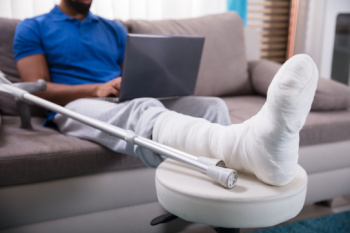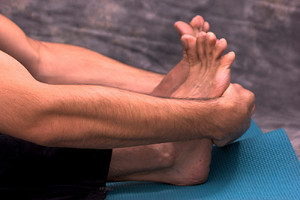Connect With Us
Blog

A broken foot occurs when one or more of the 26 bones in the foot fracture due to injury or stress. These bones include the metatarsals, phalanges, tarsals, and heel bone, all of which are vital to balance and mobility. A break can result from accidents, falls, sports injuries, or dropping something heavy on the foot. Symptoms vary depending on severity but often include sudden pain, swelling, bruising, and an inability to bear weight. In severe cases, the bone may protrude through the skin or cause visible deformity. People with improper footwear or weakened bones are more likely to experience foot fractures. A podiatrist can help by ordering X-rays to determine the location and extent of the injury and recommend appropriate treatment, which may involve immobilization or surgery. If you have broken a bone in the foot, it is suggested that you make an appointment with a podiatrist for a diagnosis and guidance on returning to activities.
A broken foot requires immediate medical attention and treatment. If you need your feet checked, contact Richard M. Allen, DPM from Idaho. our doctor can provide the care you need to keep you pain-free and on your feet.
Broken Foot Causes, Symptoms, and Treatment
A broken foot is caused by one of the bones in the foot typically breaking when bended, crushed, or stretched beyond its natural capabilities. Usually the location of the fracture indicates how the break occurred, whether it was through an object, fall, or any other type of injury.
Common Symptoms of Broken Feet:
- Bruising
- Pain
- Redness
- Swelling
- Blue in color
- Numbness
- Cold
- Misshapen
- Cuts
- Deformities
Those that suspect they have a broken foot shoot seek urgent medical attention where a medical professional could diagnose the severity.
Treatment for broken bones varies depending on the cause, severity and location. Some will require the use of splints, casts or crutches while others could even involve surgery to repair the broken bones. Personal care includes the use of ice and keeping the foot stabilized and elevated.
If you have any questions, please feel free to contact our office located in Lewiston, ID . We offer the newest diagnostic and treatment technologies for all your foot care needs.

Strong ankles are vital for stability, balance, and proper movement of the feet. Ankle mobility refers to the flexibility of the ankle joint and the surrounding muscles and tendons, which allows a full range of motion during walking or sports. Strengthening the ankles helps prevent sprains, improves balance, and reduces the risk of falls or repetitive strain injuries. Simple exercises such as ankle circles, single-leg balance, heel lifts, and toe raises enhance stability and coordination by strengthening the muscles that support the foot and ankle. Regular ankle strengthening also improves proprioception, the body’s ability to sense movement and position, which is essential for preventing missteps and ankle sprains. People who wear high heels or spend long hours standing can benefit from these exercises, as stronger ankles can offset added strain on the joints. If you experience pain or weakness in the ankles, it is suggested that you make an appointment with a podiatrist for an exam and guidance on an ankle strengthening routine.
Exercising your feet regularly with the proper foot wear is a great way to prevent injuries and build strength. If you have any concerns about your feet, contact Richard M. Allen, DPM from Idaho. our doctor can provide the care you need to keep you pain-free and on your feet.
Exercise for Your Feet
Exercise for your feet can help you gain strength, mobility and flexibility in your feet. They say that strengthening your feet can be just as rewarding as strengthening another part of the body. Your feet are very important, and we often forget about them in our daily tasks. But it is because of our feet that are we able to get going and do what we need to. For those of us fortunate enough to not have any foot problems, it is an important gesture to take care of them to ensure good health in the long run.
Some foot health exercises can include ankle pumps, tip-toeing, toe rises, lifting off the floor doing reps and sets, and flexing the toes. It is best to speak with our doctor to determine an appropriate regimen for your needs. Everyone’s needs and bodies are different, and the activities required to maintain strength in the feet vary from individual to individual.
Once you get into a routine of doing regular exercise, you may notice a difference in your feet and how strong they may become.
If you have any questions, please feel free to contact our office located in Lewiston, ID . We offer the newest diagnostic and treatment technologies for all your foot care needs.

Sever’s disease, also known as calcaneal apophysitis, is a common cause of heel pain in growing children and adolescents, especially those who are active in sports. It occurs when the growth plate in the heel becomes irritated due to repetitive stress or excessive impact. Symptoms often include heel pain during or after activity, tenderness when the heel is squeezed, limping, or difficulty walking barefoot. The affected area may appear slightly swollen or red, and the pain often worsens with running or jumping. Causes include rapid growth spurts, tight calf muscles, improper footwear, or overtraining. A podiatrist can diagnose Sever’s disease through a physical exam, gait analysis, and discussion of activity levels. Treatment focuses on reducing inflammation and relieving pressure through rest, supportive shoes, heel cups, or orthotics. Early management helps prevent recurring pain and allows children to stay active safely. It is suggested that you make an appointment with a podiatrist if your child experiences heel pain.
Sever's disease often occurs in children and teens. If your child is experiencing foot or ankle pain, see Richard M. Allen, DPM from Idaho. our doctor can treat your child’s foot and ankle needs.
Sever’s Disease
Sever’s disease is also known as calcaneal apophysitis, which is a medical condition that causes heel pain I none or both feet. The disease is known to affect children between the ages of 8 and 14.
Sever’s disease occurs when part of the child’s heel known as the growth plate (calcaneal epiphysis) is attached to the Achilles tendon. This area can suffer injury when the muscles and tendons of the growing foot do not keep pace with bone growth. Therefore, the constant pain which one experiences at the back of the heel will make the child unable to put any weight on the heel. The child is then forced to walk on their toes.
Symptoms
Acute pain – Pain associated with Sever’s disease is usually felt in the heel when the child engages in physical activity such as walking, jumping and or running.
Highly active – Children who are very active are among the most susceptible in experiencing Sever’s disease, because of the stress and tension placed on their feet.
If you have any questions, please feel free to contact our office located in Lewiston, ID . We offer the newest diagnostic and treatment technologies for all your foot care needs.

